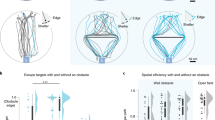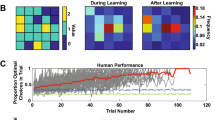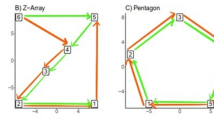Abstract
Many animals regularly return to particular locations such as hives, nests, wintering grounds or cache sites. This ability clearly implies that animals possess information that allows them to find a route from their current location to their goal. However, the nature of this information is, in many cases, unknown. One particularly important issue is whether this information encodes at least some of the geometric relationships among real-world objects, which would meet a strict definition of a cognitive map1,2. Are animals sensitive to such geometric relationships? Although there is clear evidence that animals can learn vectors that represent a goal location in terms of absolute distance and direction to a landmark, there is little evidence of any ability to extract abstract geometric rules3,4,5,6,7,8. Here we report data demonstrating that the corvid Clark's nutcracker (Nucifraga columbiana) can learn to find the point halfway between two landmarks that vary in the distance that separates them. This learning is based on a general principle, as the birds correctly find the halfway point when the landmarks are presented with new distances between them. This demonstrates the ability to find a point defined not by the relationship between a goal and a landmark but by the relationship between landmarks. Further experiments demonstrate that there were two distinct processes involved in locating the halfway point, the use of directional bearings to find the (hypothetical) line connecting the landmarks and finding the correct place along that line.
This is a preview of subscription content, access via your institution
Access options
Subscribe to this journal
Receive 51 print issues and online access
$199.00 per year
only $3.90 per issue
Buy this article
- Purchase on Springer Link
- Instant access to full article PDF
Prices may be subject to local taxes which are calculated during checkout




Similar content being viewed by others
References
Gallistel, C. R. The Organization of Learning(MIT Press, Cambridge, MA, (1990)).
Bennett, A. T. D. Do animals have cognitive maps? J. Exp. Biol. 199, 219–224 (1996).
Collett, T. S., Cartwright, B. A. & Smith, B. A. Landmark learning and visuo-spatial memories in gerbils. J. Comp. Physiol. A 158, 835–851 (1986).
Spetch, M. L., Cheng, K. & MacDonald, S. E. Learning the configuration of a landmark array: I. Touch-screen studies with pigeons and humans. J. Comp. Psych. 110, 55–68 (1996).
Spetch, M. L. et al. Use of landmark configuration in pigeons and humans: II. Generality across search tasks. J. Comp. Psych. 111, 14–24 (1997).
Biegler, R. & Morris, R. G. M. Landmark stability is a prerequisite for spatial but not discrimination learning. Nature 361, 631–633 (1993).
Biegler, R. & Morris, R. G. M. Learning stability: studies exploring whether the perceived stability of the environment influences spatial representation. J. Exp. Biol. 199, 187–193 (1996).
Cartwright, B. A. & Collett, T. S. Landmark learning in bees. J. Comp. Physiol. A 151, 521–543 (1983).
Balda, R. P. Recovery of cached seeds by a captive Nucifraga caryocatactes. Zeit. Tierpsychol. 52, 331–346 (1980).
Vander Wall, S. B. An experimental analysis of cache recovery in Clark's Nutcracker. Anim. Behav. 30, 74–84 (1982).
Balda, R. P. & Kamil, A. C. Acomparative study of cache recovery by three corvid species. Anim. Behav. 38, 486–495 (1989).
Cheng, K. & Sherry, D. F. Landmark-based spatial memory in birds (Parus atricapillus and Columba livia): The use of edges and distances to represent spatial position. J. Comp. Psychol. 106, 331–341 (1992).
Gould-Beierle, K. L. & Kamil, A. C. The use of local and global cues by Clark's nutcrackers, Nucifraga columbiana. Anim. Behav. 52, 519–528 (1996).
O'Keefe, J. & Burgess, N. Geometric determinants of the place fields of hippocampal neurons. Nature 381, 425–428 (1996).
Acknowledgements
We thank K. Cheng, S. Shettleworth, S. Yoerg, J. Templeton, A. Bond, K. Gould-Beierle, B. Gibson and C. Cink for comments on previous drafts of this paper, and D. W. Stephens for assistance with data analysis. The research was supported by The National Science Foundation and the Howard Hughes Medical Institute.
Author information
Authors and Affiliations
Corresponding author
Rights and permissions
About this article
Cite this article
Kamil, A., Jones, J. The seed-storing corvid Clark's nutcracker learns geometric relationships among landmarks. Nature 390, 276–279 (1997). https://doi.org/10.1038/36840
Received:
Accepted:
Issue Date:
DOI: https://doi.org/10.1038/36840
This article is cited by
-
Geometry-based navigation in the dark: layout symmetry facilitates spatial learning in the house cricket, Acheta domesticus, in the absence of visual cues
Animal Cognition (2023)
-
Middle identification for rhesus monkeys is influenced by number but not extent
Scientific Reports (2020)
-
Spatial cognition in western gorillas (Gorilla gorilla): an analysis of distance, linearity, and speed of travel routes
Animal Cognition (2020)
-
Understanding the role of distance, direction and cue salience in an associative model of landmark learning
Scientific Reports (2019)
-
Structural transition in the collective behavior of cognitive agents
Scientific Reports (2019)
Comments
By submitting a comment you agree to abide by our Terms and Community Guidelines. If you find something abusive or that does not comply with our terms or guidelines please flag it as inappropriate.



